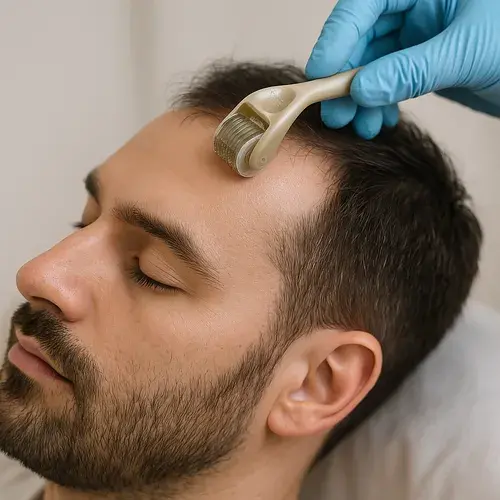Microneedling for Hair Growth: How Microneedling Stimulates Follicles for Thicker Hair
Microneedling is a minimally invasive treatment that stimulates hair follicles by boosting collagen, blood flow, and growth factors, promoting thicker, healthier hair and enhancing topical therapies.

Microneedling has emerged as a promising non-surgical treatment for hair loss and thinning hair. This minimally invasive procedure involves using tiny needles to create micro-injuries on the scalp, which triggers a series of biological responses that can lead to thicker, healthier hair. In this article, we will delve into how microneedling stimulates hair follicles and explore its potential benefits for those experiencing hair loss. What is Microneedling? Microneedling for hair loss, also known as microneedle therapy or microneedle roller treatment, involves the use of specialized tools like skin rollers or derma rollers to create micro-injuries on the scalp. This technique is similar to how micro-needling is done for skin problems, where the goal is to stimulate the natural healing response of the body. How Does Microneedling Stimulate Hair Follicles? The process of microneedling creates micro-injuries in the scalp, which triggers a wound-healing cascade. This cascade includes several key steps that ultimately lead to improved hair growth: Collagen and Elastin Production: The micro-injuries caused by microneedling stimulate the production of collagen and elastin in the scalp. These proteins are essential for maintaining healthy skin and hair. Increased collagen and elastin production help improve blood circulation in the scalp, ensuring that hair follicles receive the necessary nutrients and oxygen for growth. Enhanced Blood Flow: By improving blood circulation, microneedling ensures that hair follicles are well-nourished. This enhanced blood flow delivers essential nutrients and oxygen to the scalp, promoting the revitalization of weakened or dormant hair follicles. Stimulation of Growth Factors: The micro-injuries caused by microneedling may provoke the release of growth factors that promote hair growth. These growth factors can stimulate the hair follicles, encouraging them to produce thicker, healthier hair. Better Absorption of Topical Treatments: The microchannels created during the microneedling process facilitate better absorption of topical treatments and serums. This means that products like minoxidil (Rogaine) or platelet-rich plasma (PRP) can penetrate deeper into the scalp, enhancing their effectiveness in promoting hair regrowth. Benefits of Microneedling for Hair Growth Microneedling offers several benefits for individuals experiencing hair loss or thinning hair: Minimally Invasive: The procedure is generally well-tolerated and minimally invasive, making it a preferred choice over surgical options. Promising Results: Scientific research supports the effectiveness of microneedling in enhancing hair density and thickness. Combination Therapy: Microneedling can be combined with other treatments like topical minoxidil or PRP to enhance its benefits. Improved Follicle Health: By stimulating collagen production and improving blood flow, microneedling encourages the revitalization of weakened or dormant hair follicles. Who Can Benefit from Microneedling? Microneedling is suitable for individuals experiencing various types of hair loss, including: Androgenetic Alopecia (Male Pattern Baldness): This is the most common form of hair loss in men, characterized by receding hairline and thinning hair on the crown. Alopecia Areata: An autoimmune condition that causes patchy hair loss. General Hair Thinning: Anyone experiencing general thinning or loss of hair can benefit from microneedling. The Microneedling Process The microneedling process typically involves the following steps: Preparation: The scalp is cleaned and prepared for treatment. Application: A trained practitioner uses a specialized tool like a skin roller or derma roller to create micro-injuries on the scalp. Post-Treatment Care: After the procedure, it is crucial to follow post-treatment care instructions to maximize the benefits. This may include applying topical treatments and avoiding strenuous activities for a few days. Conclusion Microneedling for hair growth is a promising non-surgical treatment that stimulates hair follicles by enhancing collagen production, improving blood flow, and promoting the release of growth factors. While it is not a cure-all for hair loss, it offers a minimally invasive and effective way to enhance hair density and thickness. For those considering this treatment, it is essential to consult with a qualified healthcare professional or licensed dermatologist to determine if microneedling is appropriate for their specific condition and to ensure optimal results.
Need Professional Consultation?
Our professional doctors will provide detailed hair and scalp analysis and develop personalized treatment plans.
Book Consultation Now